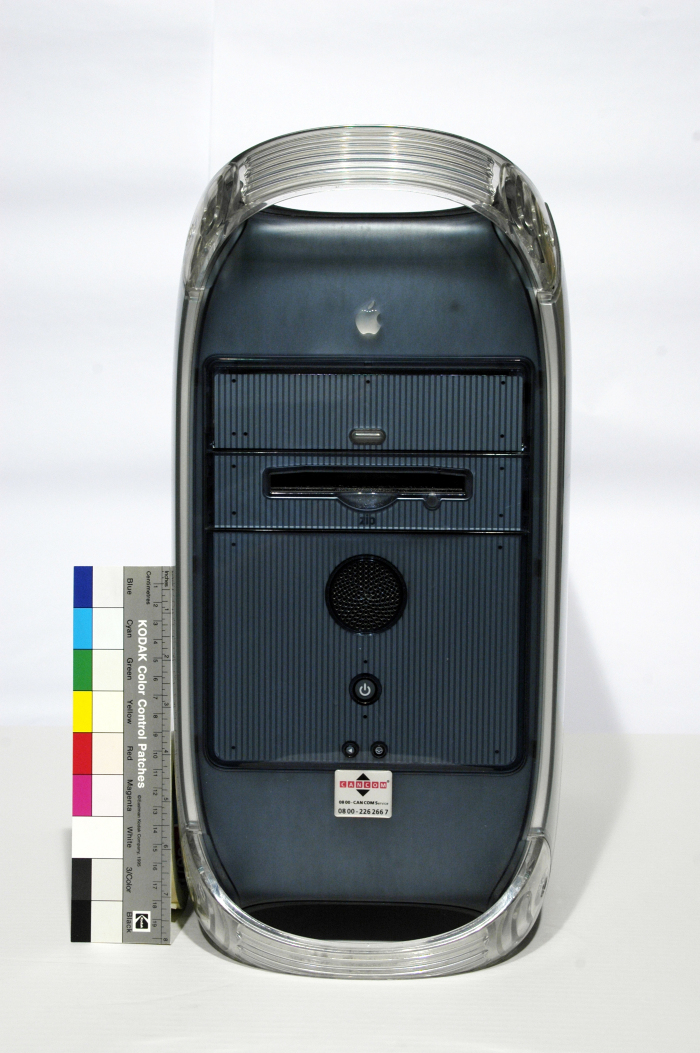Rechner Apple Power Macintosh G4
W/2013/10/00088

Power Macintosh oder auch Power Mac ist der Produktname für die Macintosh-Modelle des Unternehmens Apple mit PowerPC-Prozessor. Die vorher nur umgangssprachlich benutzte Bezeichnung „Power Mac“ wird von Apple seit den G4-Modellen offiziell verwendet, zugleich wurde der Begriff „Macintosh“ fallen gelassen.
The Power Mac G4 (originally Power Macintosh G4) is a series of personal computers that was designed, manufactured, and sold by Apple between 1999 and 2004. They used the PowerPC G4 (PPC74xx) series of microprocessors. They were heralded by Apple to be the first personal supercomputers, reaching speeds of 4 to 20 Gigaflops. They were both the last Macintoshes to boot natively into Classic Mac OS and the first to boot exclusively into Mac OS X.
Original models
The original Apple Power Mac G4, code name \"Yikes!\", was introduced at the Seybold conference in San Francisco on August 31, 1999,[1] with 400 MHz, 450 MHz and 500 MHz configurations available. In October 1999, Apple was forced to postpone the 500 MHz because of poor yield of the 500 MHz chips. In response, Apple “speed dumped” the processor speed in each configuration by 50 MHz but caused some controversy by not decreasing the price of the machines.[2]
\"Graphite\" Power Mac G4
The early 400 MHz (later 350 MHz) PCI-based version used a motherboard identical to the one used in Power Macintosh G3 (Blue & White) computers including the use of Zero Insertion Force (ZIF) processors sockets[3] (minus the ADB port), in a \"graphite\" colored case and with the new Motorola PowerPC 7400 (G4) CPU. The higher-speed models, code name \"Sawtooth\", used a greatly modified motherboard design with AGP 2x graphics (replacing the 66 MHz PCI slot). In December 1999, the entire Power Mac G4 line was updated to the AGP motherboard.
Power Mac G4 Graphite with upgraded CPU
The machines featured DVD-ROM drives as standard. The 400 MHz and 450 MHz versions had 100 MB Zip drives as standard equipment, and as an option on the 350 MHz Sawtooth. This series had a 100 MHz system bus and four PC100 SDRAM slots for up to 2 GB of RAM (1.5 GB under Mac OS 9). The AGP Power Macs were the first to include an AirPort slot and DVI video port.
The 500 MHz version was reintroduced on February 16, 2000, accompanied by 400 MHz and 450 MHz models. DVD-RAM and Zip drives featured on these later 450 MHz and 500 MHz versions and were an option on the 400 MHz.
Apple\'s marketing name for all these early AGP models is Power Mac AGP Graphics. The code name Sawtooth was used internally before release and became the popular designation among enthusiasts.
The design was updated at the Macworld Expo New York on July 19, 2000; the new revision included dual-processor 450 MHz and 500 MHz versions, and a low-end single CPU 400 MHz model. It was also the first personal computer to include gigabit Ethernet as standard. Most people saw this revision as a stopgap release, because higher clocked G4s were not available; the G4’s Motorola XPC107 “Grackle” PCI/Memory controller prevented the G4 from hitting speeds higher than 500 MHz.[citation needed] The dual 500 MHz models featured DVD-RAM optical drive. Zip drives were optional on all models. These models also introduced Apple\'s proprietary Apple Display Connector video port.
Apple\'s marketing name for this series is the Power Mac Gigabit Ethernet. The code name was Mystic.
Quelle: http://en.wikipedia.org/wiki/Power_Mac_G4